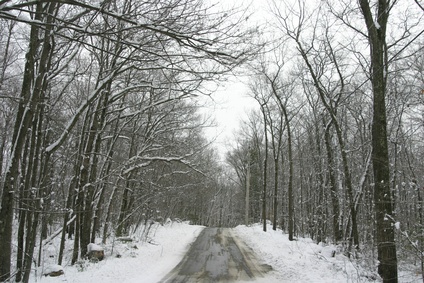
Although all-season tires may suffice for snow driving in coastal cities such as Seattle and Memphis, a tire designed specifically for cold weather is required for driving in frigid places like Denver and rural Illinois during the height of snow season. Snow tires, which manufacturers now prefer to call winter tires, are designed for maximum traction and minimum sliding in icy and snowy conditions.
The all-season tires that come standard on most vehicles are designed to hold up to an acceptable standard in both hot and cold weather, but they fall short in extreme climates. In truly frigid temperatures as high as -7 degrees Fahrenheit, all-season tires harden and become more likely to skid. Winter tires are made of a rubber compound that stays soft, malleable and able to grip the road in icy conditions with temperatures as low as -40 degrees Fahrenheit. In addition, winter tires are designed with special tread patterns, shot through with shallow grooves that push the snow aside and dig down to the surface of the road to maximize traction.
Traditional winter traction tires have deep treads that are scored with shallow lines for extra traction. They are usually available with optional metal studs, which increase traction in icy conditions. Use of studded winter tires is prohibited year-round in some places, such as Michigan and Alabama, and restricted in others. For example, they are allowed from Nov. 2nd to April 30 in Massachusetts. High-tech winter tires are designed for the maximum traction possible without the use of metal studs. Finally, high-speed winter tires sacrifice some of the deep snow and bare ice traction capability of high-tech and traditional winter tires for better handling and increased speed on dry and wet roads in freezing temperatures.
No matter which type of winter tire you equip your two-wheel drive pickup with, it is always safer to have a set of four matching tires. In snowy or otherwise treacherous situations, your winter tires may keep traction while your all-season tires may skid out of control. This is especially dangerous when driving a large or unwieldy vehicle such as a pickup truck. Since winter tires are only to be driven on during the winter, having only two winter tires will cause the two all-season tires on the vehicle to wear unevenly. Be careful mixing brands and sizes, as well. Ideally, all four tires should be identical. But at least be sure that the two tires on a single axle match exactly.
If you absolutely must have only two winter tires on your pickup, make sure they are installed on the rear axle. No matter whether your two-wheel drive pickup has front- or rear-wheel drive, skidding front tires are easier to correct than skidding back tires.
Though many pickup trucks are equipped with traction control devices such as anti-lock brakes and anti-slip traction systems, these devices do not actually provide traction and will not negate the need for good winter tires. AST prevents tire spinning by reducing engine power or applying the brakes while ABS prevents tire locking by selectively pumping and releasing pressure on the brakes. Do not depend on these systems. It bears repeating: they do not provide traction and will not make up for failing or mismatched tires.